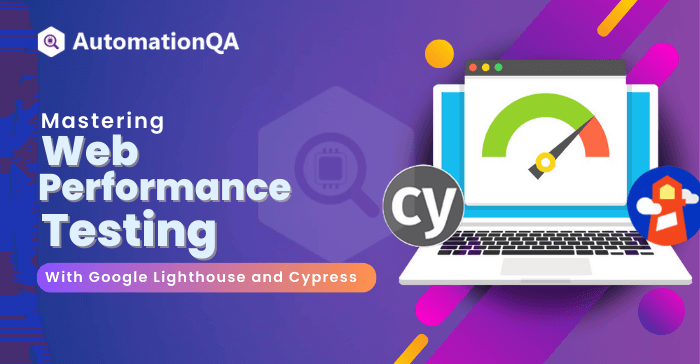
Welcome to the ultimate guide to achieving exceptional web performance through the power of Google Lighthouse and Cypress. Since the pandemic, mobile applications and websites have become the preferred means of fulfilling essential needs such as grocery shopping and bill payments. Suppose these websites and apps take a long time to load. In such cases, customers might abandon your services in favor of your competitors!
Are you ready to unlock the secrets of optimizing your website’s speed, skyrocketing its performance, and outshining your competitors in digital success? Look no further. This comprehensive guide will reveal expert strategies and insights that will empower you to leave a trail of awe-inspiring web experiences in your wake. Brace yourself as we dive deep into web performance testing tools, armed with cutting-edge tools and an unwavering commitment to excellence.
What Is Google Lighthouse?
Lighthouse is a tool integrated into the Chrome browser, offering various features to assess the quality of your web pages. Testers often utilize Lighthouse for its performance metrics capabilities. It aids in identifying performance issues on your website, such as inconsistent images, inefficient underlying code, and slow-loading pages.
Running performance tests using Chrome and Lighthouse is straightforward. You can inspect your site and utilize the Lighthouse tab to initiate the trials. Additionally, the Lighthouse CLI (Command Line Interface) allows you to use Lighthouse powered by Google.
If you use Cypress to test your web applications, you can combine the Lighthouse CLI with the Cypress-Audit plugin to conduct performance metric assessments.
Leveraging Google Lighthouse For Web Performance Testing
Google’s Lighthouse is a potent open-source tool that can help you analyze your website’s performance in terms of SEO. You can leverage Lighthouse by following the steps discussed below:
1. Install Lighthouse
Start by installing Lighthouse as a Chrome browser extension or a command-line tool, depending on your preference. Once installed, you can access it quickly and initiate performance tests on any web page.
2. Conduct Performance Audits
Perform a comprehensive performance audit using Lighthouse. It will offer insightful information on the performance of your website, including load times, rendering, asset sizes, and more. Prioritise areas that need improvement according to how they will affect user experience.
3. Optimize Website Speed
Lighthouse provides in-depth and valuable information about the website’s performance. This knowledge helps to create proactive optimization strategies. It involves minimizing server response times, leveraging browser caching, compressing images, and optimizing code.
4. Enhance Website Accessibility
Google Lighthouse also evaluates your website’s accessibility, ensuring that it can be used effectively by users with disabilities. Improve accessibility by implementing proper HTML structure, adding alt text to images, and enabling keyboard navigation. These enhancements not only benefit users but also contribute to improved SEO.
5. Boost SEO Performance
Lighthouse evaluates various aspects of your website’s SEO, including metadata, structured data, and mobile-friendliness. Lighthouse’s suggestions help increase your website presence. It can include optimizing meta tags, improving keyword usage, and ensuring mobile responsiveness.
Leveraging Cypress For Automated Testing for Performance
You may create and run automated tests for your website using Cypress, a powerful end-to-end testing platform. It provides an intuitive interface and robust capabilities for testing website performance. Here’s how you can leverage the Cypress automation tool effectively:
1. Set Up Cypress
Begin by installing Cypress and setting up the required dependencies. Cypress provides detailed documentation on how to get started with your testing environment.
2. Write Performance Tests
Writing JavaScript performance tests with Cypress allows you to imitate user interactions and track response times. Focus on testing critical user flows and key functionalities that impact performance. By automating these tests, you can ensure consistent and reliable performance evaluations.
3. Analyze Test Results
Once you execute your performance tests, Cypress provides detailed test results and performance metrics. Analyze these results to identify improvement. Look for slow-loading elements, excessive network requests, or inefficient code that may impact performance.
4. Optimize and Retest
Based on the insights gained from the test results, make necessary optimizations to enhance your website’s performance. It may involve code refactoring, optimizing assets, or leveraging caching mechanisms. Retest your website to confirm the effects of the optimizations after implementing the changes.
Best Practices For Performance evaluation With Cypress
Utilize varying geographies
Cypress automation services offer geolocation features that enable you to simulate different geographic locations. Consider testing your application’s performance across multiple regions to ensure a consistent experience for users worldwide.
Set custom thresholds in Lighthouse
Recognize that each web application is unique; predefined thresholds may not accurately reflect your performance requirements. Establish custom thresholds tailored to your application, allowing you to assess performance against your desired benchmarks.
Run Lighthouse tests regularly and on multiple devices
Incorporate Lighthouse tests as a regular part of your test suite. Perform tests frequently to track performance changes over time and identify any potential regressions. Run Lighthouse tests on multiple devices to evaluate your application’s performance across different platforms and screen sizes.
Final Thoughts
Congratulations, you are now armed with the knowledge and testing tools to revolutionize your website’s performance and leave your competition in the dust. By harnessing the power of Google Lighthouse and Cypress, you can fine-tune every aspect of your website to deliver a seamless and lightning-fast user experience. To boost your SEO performance, your website must be optimized, accessible, and perfectly tuned.
Embrace the journey of continuous improvement, never settling for mediocrity. Stay ahead of the game, outrank your competitors, and watch as your website soars to new heights of success. The future of web performance testing is in your hands—embrace it and pave the way for unparalleled online excellence.
